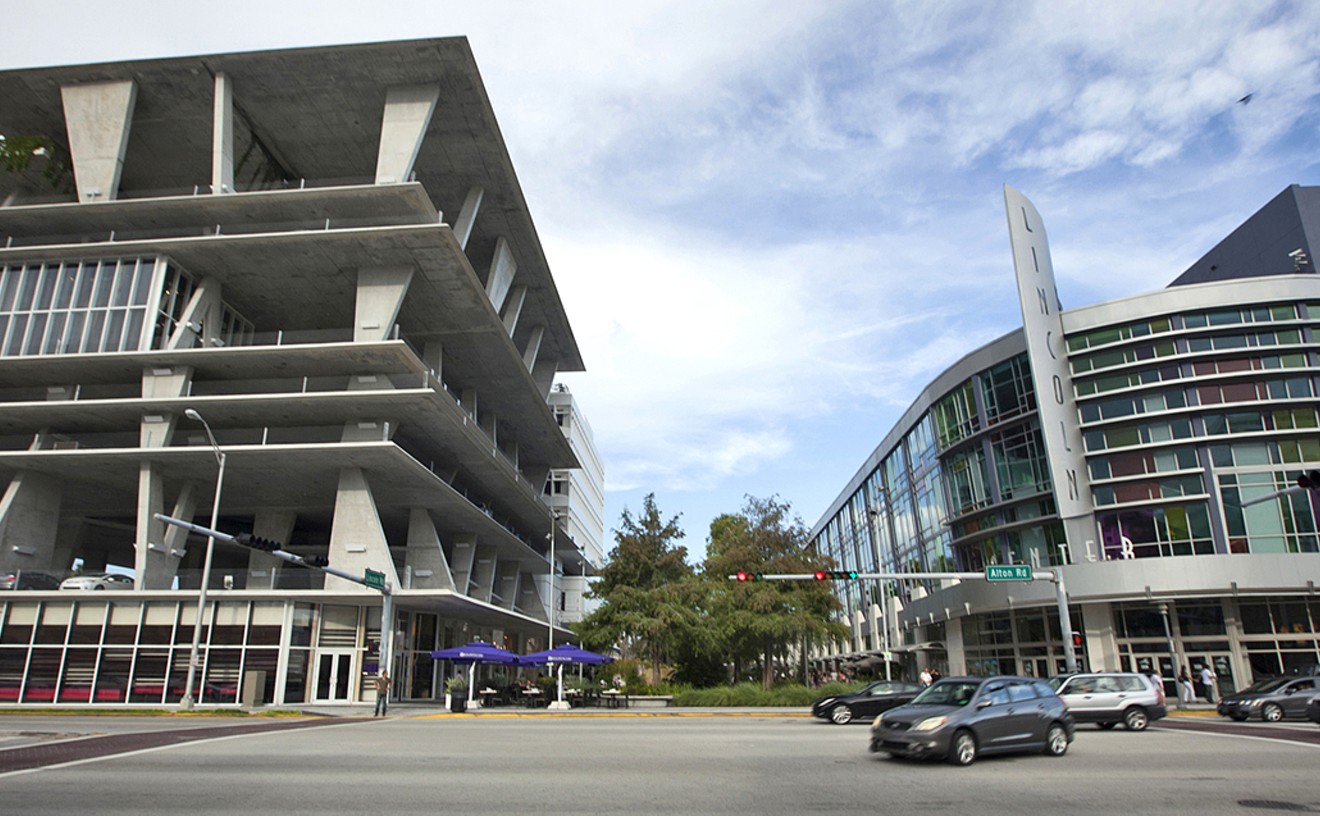It's hard to prove a negative, but the next time you step into an elevator and don't plunge to your death, you might want to thank Michael Chavez. A county employee for more than 20 years, he has held his current position since 2003. In 2006, Patrick Fraser of WSVN-TV (Channel 7) phoned Chavez on behalf of an elderly couple trapped in their apartment by a broken elevator. Chavez helped get it fixed. His department, Fraser said, "moved as quickly as I have ever seen a government agency move." New Times had the pleasure of coming across this county bureaucrat while inquiring about a pair of condo towers with terrible elevators. Chavez, to our surprise, not only handled the call himself but also rattled off their history from memory, pulling additional records as he spoke and promising to investigate the matter. He was candid, responsive, and, apparently, personally troubled by the report. He followed up with an inspection, a notice of violation, and a fine. "We haven't heard any complaints since," he told New Times. "I guess no news is good news."
Best Bureaucrat
Michael Chavez, chief elevator inspector for Miami-Dade County
- 201 W. Flagler St., Miami, 33130 Map
- 305-375-1577
Best Cantor
Cantor George Mordechai

Bored with the humdrum, off-key murmurings that pass for song at your local Shabbat service? Secretly disenchanted with the perky pop tune prayers that have replaced many a heart-wrenching Jewish dirge? Look ye no further: Cantor George Mordechai is in da house of worship. An Australian native and the son of Iraqi Jews, Mordechai brings a blend of Middle Eastern, Indian, Eastern, and Western musical traditions to his Shabbat prayers at Temple Emmanu-El, a.k.a. "The South Beach Synagogue." It doesn't hurt that Rabbi Kliel Rose, the congregation's young, bearded leader, is crazy about Mordechai's music, and holds a note well enough to do back-up vocals, making for a show worthy of kicking off a well-deserved — and Almighty-decreed — day of rest. Services are Friday nights at 7:30 (there is an optional meditation at 7).
- 1701 Washington Ave., Miami Beach, 33139 Map
- 305-535-5661
- tesobe.org
Best Cause to Rally For/Against
The Streetcar
Once upon a time — between 1925 and 1931, to be precise — the residents of Miami, lacking giant Hummers, boarded streetcars to get around the city. Then car companies lobbied for the destruction of the rails, and the on-street transit system was no more. Now Mayor Manny Diaz wants to bring the streetcar back. Maybe you like it, maybe you hate it, but Mayor Diaz's plan to build a $200-million system connecting Little Haiti, the Design District, Wynwood, and downtown is one of those issues that gets city activists fired up. Those on the pro-streetcar side tend to see it as the eco-friendly, neo-urban kick-in-the-pants the otherwise car-dominated town needs to move it into the 21st Century. But not so fast: Opponents such as Norman Braman (see Best Citizen) think it's a big, fat waste of money. And Commissioner Marc Sarnoff, elected on an anti-streetcar platform, has called it a "glorified bus." So far, the scale seems to be tipping in the streetcar's favor. But don't let the politicians decide the matter. If you have an opinion, go ahead and clamor for it. That's what democracy is all about.
Best Cheap Thrill
Sunday nights at the Lincoln Road Farmers' Market

It's Sunday evening, you partied too much this weekend, and those doldrums are settling in. Stave off a bummer of a Monday with a whole slew of flowers. Once the sun goes down, stuff a few bills in your pocket and head to the farmers' market on Lincoln Road in South Beach. That's when sellers slash prices to a buck or two a bunch. For a mere $10, you can cart away enough flowers to make your home feel like the abode of a Coral Gables socialite. Or buy roses, which usually go for $5 a dozen. Take them to work and start a spicy rumor about you and your fabulously rich (and invented) lover. Monday mornings just got a little more thrilling.
- Lincoln Rd., Miami Beach, 33139 Map
- 305-534-9857
- lincolnroadmall.com
Best Chutzpah
The Megaplan
The City of Miami's omnibus redevelopment package, a.k.a. The Megaplan, would under any circumstances be called a boondoggle, folly, or even pure insanity. What qualifies it as chutzpah, too, is that this past December, commissioners decided they didn't need to ask voters about redirecting billions of their dollars toward capricious whims instead of curing the poverty much of the money was meant to alleviate. Of course, the voters had already said they wanted $50 million of it to be spent repairing the Orange Bowl — which is being mega-torn down under the plan — so who gives a shit what the voters think? Or maybe it qualifies as chutzpah because several Miami-Dade County commissioners complained they had less than two days to review the extensive plans before their vote — which mysteriously was also a go for this hell-spawn of a love affair between Leviathan and Cthulhu. What exactly do the commissioners expect the public to buy them? A tunnel that no one is sure can physically be built, a baseball stadium unanimously supported by all 25 Marlins fans, a soccer stadium without hope for a team, an art museum in a flood zone, funding for an unprofitable arts center, and a few other tidbits. That's more than $3 billion worth of chutzpah. Feh!
Best Citizen
Norman Braman
Sometimes a city needs a man of wealth and power to stop the wealthy and powerful from ramming through a massive boondoggle at the public's expense. In Miami's case, this is Norman Braman. The multimillionaire philanthropist and luxury auto dealer has demonstrated he is unafraid to use his personal financial resources to defeat proposals that will cost taxpayers and benefit special interests. In 1982, he led a successful campaign against a city sales tax that would have paid to renovate the Orange Bowl for then-Miami Dolphins owner Joe Robbie. In 1999, he helped defeat a one-cent sales tax that would have generated $1 billion for a doubtful mass transit plan. And now Braman is doing everything in his power to whack a $3-billion interlocal agreement between the City of Miami and Miami-Dade County for the megaplan. In addition to suing the city and the county, Braman is publicly speaking out against it. And he commissioned a poll that found Republican State House Speaker Marco Rubio would offer a formidable challenge to Miami-Dade Mayor Carlos Alvarez in the upcoming campaign. Oh, and did we mention Alvarez is one of the interlocal agreement's key supporters? Braman has also dedicated his philanthropic work to the memory of the six million Jews killed during World War II. As chairman emeritus of the Holocaust Memorial, Braman has contributed more than $1 million to the monument. And he was instrumental in adding the name of Daniel Pearl, the American journalist who was abducted and killed by terrorists in 2002, to the memorial's wall. Miamians should stand up and applaud Braman for his independent thinking.
Best Confession
Adriana Velasquez
Last November, a crying woman in her late twenties appeared at a media briefing outside Miami Police headquarters. She told reporters a man had assaulted her in Little Havana. He had cornrows, a "LOVE MOM" tattoo, and a dime-size mole. Women across the city were rattled, and police set off to search. Some 100 hours of investigative work later, Adriana Velasquez told police she had cut her clothes and self for "sympathy, because she was having marital problems." Then the artful actress pleaded emotional problems before fainting on-camera. But cops didn't swallow this part of her story. They booked her on a misdemeanor.
Best Costume Design
Ellis Tillman for Altar Boyz, Martha Mitchell Calling, and Urinetown

Ellis Tillman's work at Actors' Playhouse this year was subtle and awe-inspiring. The vaguely ill-fitting, vaguely daft duds on the members of the Altar Boyz seemed to reflect the awkwardness of their stock poses. Martha Mitchell's expensively lurid ensemble in Martha Mitchell Calling spoke of old-school classiness trying to get along in a world where everything comes cheaper by the day. And in Urinetown, the mere cut of Cherlyn Franco's potato-sack dress captured the feeling of dumb youth struggling with the implications of adult wisdom. Glen Ballard's uniform as the psychotic Officer Comstock suggested Patrick Bateman with a badge, Tally Sessions's Bobby Strong character looked like a dystopian Rob Roy, and Rachel Jones's matronly rags conveyed poverty, dignity, and sternness. Doing a lot with a little is always better than doing a little with a lot, and in Urinetown's worst neighborhoods, Tillman outdid himself again and again.
- 280 Miracle Mile, Coral Gables, 33134 Map
- 305-444-9293
- actorsplayhouse.org
Best Criminal Conviction of the Past Year
Victor Caraballo
It was the most horrific, senseless crime: In April 2002, 18-year-old Ana Maria Angel and her boyfriend, 18-year-old Nelson Portobanco, were kidnapped by five men as they strolled romantically through South Pointe Park in South Beach. Ana Maria was gang-raped, while Nelson was beaten, stabbed, and left to die on the side of I-95. Both were robbed. Ana Maria was shot to death as she begged for her life. Five men were eventually charged in the crime — Victor Caraballo, his brother Hector Caraballo, Cesar Mena, Joel Lebron, and Jesus Roman. In 2007, Victor went to trial first, and a Miami-Dade jury not only convicted him but also sentenced him to the death chamber. "If the death penalty was ever merited, this is the case," said State Attorney Katherine Fernandez-Rundle.
Best Dance Company
Miami Contemporary Dance Company
When someone in Miami says, "I'm a dancer," people respond, "At which club?" But there is a fragile, growing dance scene here, and the Miami Contemporary Dance Company is at the center of it. Twelve full-time hoofers do their physically and emotionally demanding work Monday through Friday at the company's small studio. Dancing is their day job. And that makes MCDC founder and artistic director Ray Sullivan immensely proud. Now in its eighth season, MCDC continues to create fulfilling, sustaining works — often with a social justice message — such as Sullivan's Tango Undressed, for world-class professional dancers. It has built a much-needed dance education program for children and adults in Miami Beach. Just surviving in this rough economic and philanthropic climate is admirable, but Sullivan has big plans. Instead of being presumed strippers, dancers here someday will be asked, "With which company?" MCDC is a movement.





